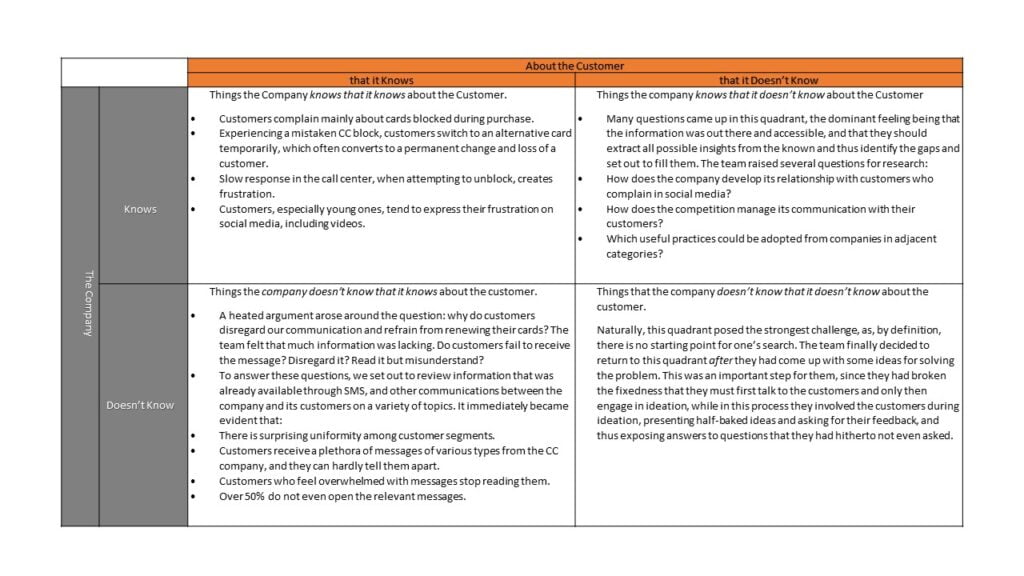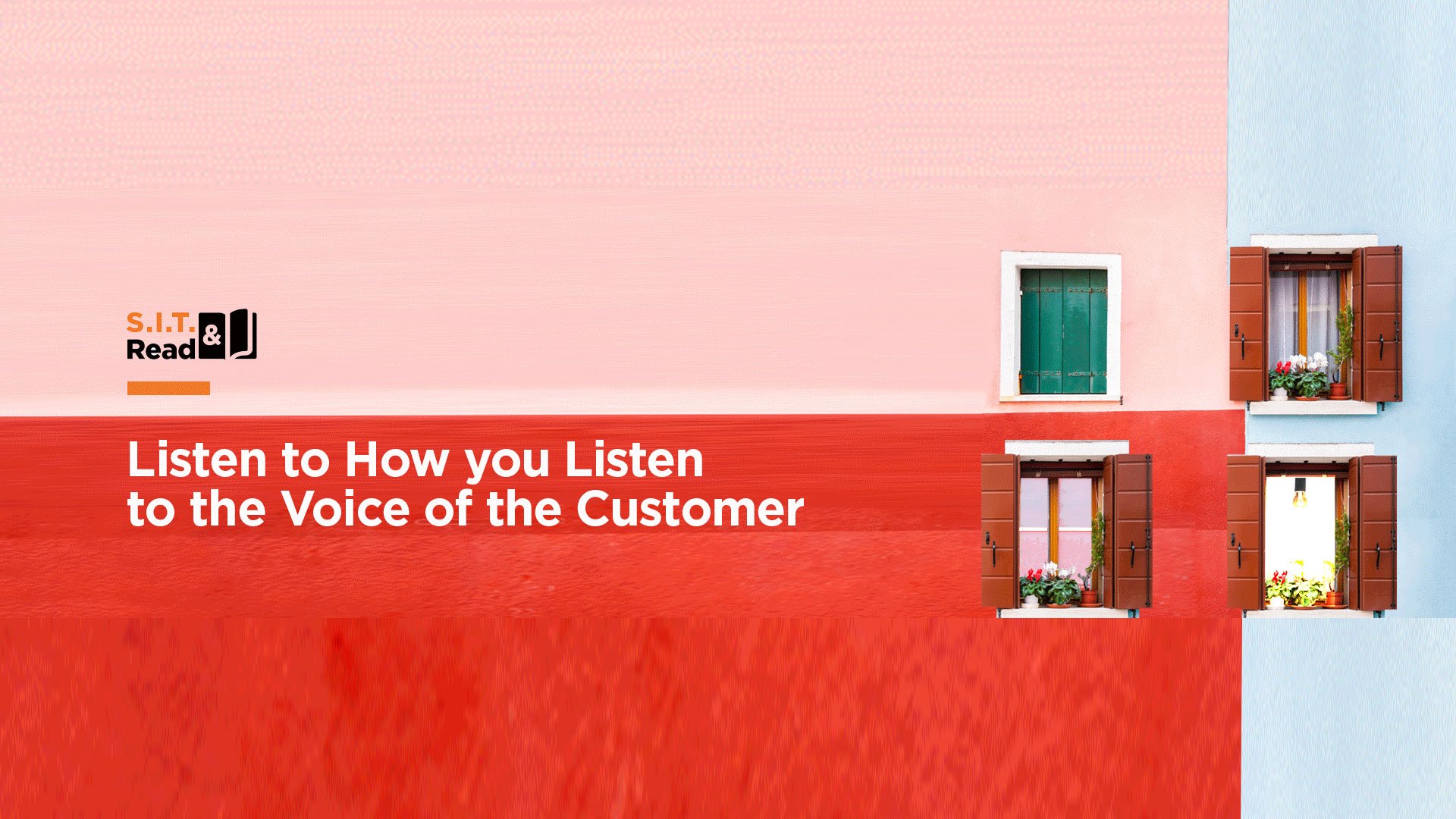By Nurit Shalev, CDEO (Chief Development & Empowerment Officer) and Amnon Levav, CIO (Chief Innovation Officer), in SIT – Systematic Inventive Thinking
This post brings together two very well-known concepts, the first, a key topic in the world of marketing and the second, a technique that originated in the realm of psychology and self-help:
- Voice of the Customer
- Johari window
When Nurit came to me with the initial draft of this post, the first thing that occurred to me was: great stuff, but this combination must have appeared in dozens of publications already. A couple of Google-hours later I came to the following surprising conclusion, which is our rationale for sharing with you this application of the Johari Window technique to the practice of listening to the VoC:
This is the first time (as far as we’ve seen), that the Johari Window is used not to analyze how customers perceive the company but what the company knows about its customers.
AS we all know, companies very often embark on research designed to glean insights about their current or prospective customers, whether to identify “unmet needs”, drive design of new products or offerings, or better communicate their benefits in order to eventually sell them. Our suggestion (and novelty): Before setting out to ask your customers or observe them, ask yourself and map out what you know about them, using the Johari Window framework.

What can the company learn from these quadrants, and how can this be put into practice?
1.The company already knows plenty about its customers, and the first quadrant shows what the company knows that it knows, through a variety of sources: salespeople, customer service, complaints, social media, etc. Very often, the customer also knows that you know, so: a) why waste your energy on re-verifying, and b) why annoy your customers by demonstrating that you need to be told yet again? Unfortunately, we often find our clients exploring this quadrant, mostly because it is easier to cover familiar territory. Make sure you organize this type of existing knowledge well and avoid the practice of setting out to rediscover it.
2. The second quadrant seems enticing: stuff you know that you don’t know about the customer. Tempting because you know what you’re looking for, and you know that once you find it you have expanded your knowledge of your customers. But beware: make sure you figure out why you want to know what you don’t about your customers. First, maybe you don’t know because the customer doesn’t want you to know, maybe it’s not your business to know. Second, will this information be useful, operable? Take care not to spend time nor bother your customers for collecting information that will never be utilized – you will be breaking the informal pact by which your customer agrees to share their data in return for your making good use of it for their benefit. It can, nevertheless, be fruitful to imagine what you could do with data or information that is currently unavailable. Especially when thinking of Digital Transformation, uses for data are often invented or discovered only after the data has been collected. Explore this quadrant, therefore, but handle with care.
3. The third quadrant describes a blind spot with high potential for easy wins – what you don’t know that you know. This is all the data and information that the company has, but is not aware of possessing, usually due to one or several of the following:
- Data, or even information are strewn around in an unstructured and unorganized fashion;
- Your own assumptions or cognitive fixedness prevent you from realizing what you know;
- Lack of communication and silos deny access to data to those who could potentially use it within the organization.
The danger in these cases is, again, disappointment among customers who feel that they have supplied information but have not received anything in return. The potential, on the other hand, is huge. No need to spend time and resources on research, no need to take up more customer’s time, only open your eyes and mind and enjoy the fruits of information that you already possess.
4. The fourth quadrant is the most intriguing. The assumption here is that there exists information out there that will probably not be accessible using your standard procedures. Since you don’t know that you don’t know, not only are you not cognizant of the answers, but you are even ignorant of the questions. You will, therefore, need to be creative. Perhaps you can engage your customers in a process of co-creation, while observing them and listening carefully. Or you can use empathic design or other anthropologically based techniques for observing customers with a clean slate, open to discovering information that you had not set out to look for, and the customer may not have even been aware that existed. Companies would do wisely to develop these kinds of procedures and abilities, for it is in this domain that competitively valuable insights can arise. A caveat is in place, though: there is much information for which you should not rely on your customers. They not only cannot tell you what they will need in the future, they very often are not even aware of what they need or could want now. One of the worst strategies for coming up with novel ideas is asking your customers to supply them.

The following short case study demonstrates how the Johari analysis plays out in this context. As we prepared for a pipeline development project with one of our clients, a credit card company, the VP Marketing asked that as a first step we conduct some consumer research: “Let’s learn from our customers, listen to what they want.” All members of his management team, sitting in the room, fell silent. Their unease was palpable. They needed very little prodding to explain why: “Not another research project!”, “We have so much data already that we’re not using.” “Same questions, same answers, same ppt presentation, report to the board, no action?” Our suggestion was, therefore, to kick-off by mapping out the company’s knowledge situation as explained above. This was the result:

The information collected through this analysis led to a variety of insights, such as:
The customer obviously lived a negative experience when their card was blocked, but this was exacerbated by the presence of others, such as the attendant at the checkout, the customer’s partner, bystanders watching etc. The experience was often described using expressions such as: shame, offense, impotence, anger.
- Some of the customers turned to the call center in real time, but most reported that response times were inadequate to the situation, failing to resolve the embarrassing situation.
- Emotional responses to the blocking of one’s card were pretty much universal across customer segments, but reactions differed widely, including the use of social media.
- In most cases cards were blocked due to the customer’s failure to renew their card or enable its use abroad. In both cases, the customer had received notification of the need to act but had disregarded this communication.
- Communication overload was the main reason for disregarding these important messages that were lost in the flood of less important ones.
Based on the insights garnered through this analysis, the team went on to ideate solutions, converging to two viable and complementary concepts. At this point the team felt that they needed very little customer validation, as the ideas had been based on a deep and solid analysis of the huge amount of knowledge they had of their customers.
Time and again we find that professionals have much more information about their customers preferences and needs than they are aware of. In these cases what is required is a comprehensive and structured analysis of the existing knowledge leading to a focused search for what is missing.
Remember:
- Don’t ask about what you already know. The customer knows that you know.
- Don’t ask about what you don’t need to know.
- Don’t rely on the customer for what the customer doesn’t know (e.g. ideas, future needs).
- Trust your professionals, especially those with frontline experience, and their knowledge of their customers. Listen to the VoP (Voice of the Professional), and don’t settle for their initial response.
- Challenge your people to challenge what they think they know, to uncover what else they know.
Knowing your customer is the basis for the success of any business, hence the crucial importance of listening to the voice of the customer, but much depends on how you listen, what you search for and mostly – your awareness of what you know and what to do with it. Our variant of the Johari Window, applied to analyzing what you know about your customer’s knowledge of you, can be a useful first step.
